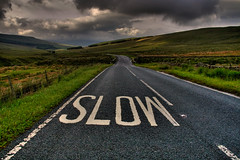 We missed our partner in crime – er- podcasting, Ed (how can life interfere with our podcasts! Alas!) but Matt Moore and I had a fun time yesterday as he recorded our conversation about Slow Communities . We rambled for about 20 minutes, then finished.
We missed our partner in crime – er- podcasting, Ed (how can life interfere with our podcasts! Alas!) but Matt Moore and I had a fun time yesterday as he recorded our conversation about Slow Communities . We rambled for about 20 minutes, then finished.
Afterwards I said – hm, we didn’t get to any practical ideas about what to DO about volume and speed, and how to be discerning about when to go fast or slow. Matt suggests sending us postcards! 😉 I am copying the whole post here… hm, is that rude of me? I want to annotate the timestamp notes, and this seemed the most efficient way.
Nancy has been writing & talking a lot about “slow community” recently – video, slides & post here & here. Sadly Ed Mitchell couldn’t join us as planned (but we’ll nab him again in the future).
One thing we didn’t tackle in the podcast was the matter of practical tactics: What should community members & coordinators do?
Answers on a postcard please…
00:00 – Nancy’s conversations about slow communities
03:30 – Matt’s fast community anecdote
* N’s note: what to do/how to respond to unrealistic expectations about speed of community building and expectations of learning through reflection if you don’t take time to reflect!
06:00 – When is slow appropriate?
* and for whom and how do we know if my slow is your fast?
06:30 – The importance of sustainability
* hm, and now that I think about it, also scalability. Is “community” generically scalable? I don’t think so. Does it have costs to sustain? Yup. Are the benefits sufficient and are we willing to pay the freight?
07:15 – Fast is good for social media experiments
* and brainstorming, iterative design, and getting the chores done…
08:00 – We need to learn & reflect
* do leaders role model reflection and learning?
10:30 – Rhythm, pausing & athletics
* I want to dive deeper into this “rhythm” thing…
12:15 – Organisational seasons & hurricanes
14:00 – More is not necessarily better
15:30 – Community obesity
* Oh, I LOVED this one. A Matt Moore gem, for sure. Also Infoluenza…
* Matt forgot to include “community and network speedometers” — what does making the pace visible do to our awareness and subsequent choices/behaviors? A feedback mechanism showing me how many emails I have read/written, groups responded to, blog posts, tweets… and time spent on them? Dunno?
* Multimembership
* How many relationships… and what is the depth/quality of those relationships
17:00 – Networks & communities
* are networks fast and communities slow? I don’t think that is quite it, but something is there…
18:00 – Admitting that you have a problem
* Moi?
20:00 – Mindfulness & self-awareness as critical skills
* It is almost impossible to micromanage in many of our current environments, so self management becomes a critical skill and practice
22:30 – Nancy applies the brakes with meditation
24:00 – What do we really need?
Photo credit, Flickr, CC